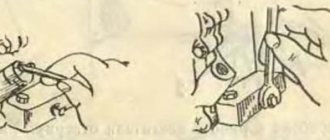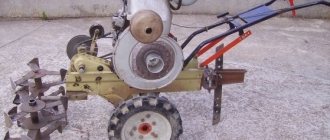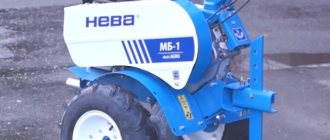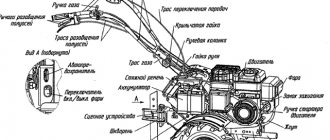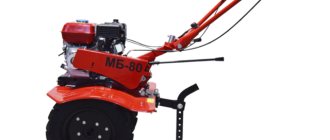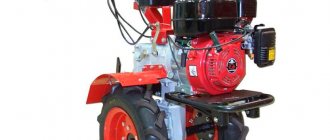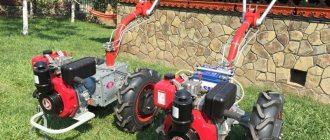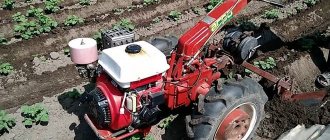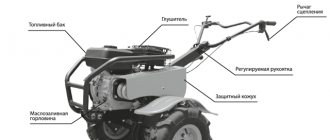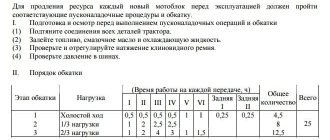Summer residents, entrepreneurs, farmers - everyone is interested in gardening equipment working for a long time and without interruption. Proper maintenance and operation of a walk-behind tractor or cultivator helps extend the life of the equipment and increase its productivity. One of the most important structural elements of a walk-behind tractor is the gearbox, and its performance depends on what kind of oil is poured into the walk-behind tractor’s gearbox. Each owner should know what kind of lubricant should be used in the gearbox and what is the frequency of its replacement.
What kind of oil is poured?
Many people are interested in what kind of oil to pour into the gearbox of a walk-behind tractor? To answer this question, you need to take into account several factors, the main one of which is the manufacturer's recommendation regarding the type of oil.
You also need to be guided by price, without buying very cheap liquids, because they are unlikely to be of adequate quality.
No matter how reliable the original tracks of a snowmobile are, sooner or later during active use of the machine there is a need to replace them. Here is everything about snowmobile tracks from the Composite company.
A garden sprayer is an indispensable assistant in pest control. By clicking on the link you can get acquainted with the gasoline backpack garden sprayer.
MAZ-5337 appeared in the second half of the eighties of the last century. MAZ-5337 is a versatile, powerful and very reliable truck.
In general, oils can be of various types:
- SAE. These types of oils cope very well with sudden temperature changes, so they can be used all year round.
- The selection process is as follows: you need to look at the number in front of the letter W - a lower value will indicate that the oil is very well adapted to low temperatures (the smallest is 0W). If the letter W is not on the label, then this oil is suitable for the summer period.
- API. In this case, the letters in the marking will indicate the type of engine - gasoline or diesel. Accordingly, a certain letter will indicate that the oil is suitable for gasoline units, and another – for diesel units.
- The numbers will indicate the type of engine, i.e. number 4 means the oil should be used for a 4-stroke engine, etc. The EC value is the degree of energy conservation, i.e. The higher the value, the better the quality of the oil.
- ASEA. The highest number in the labeling will indicate that the oil can function in very difficult conditions.
- GOST 17479, 1-85. These indicators characterize the degree of viscosity of the oil. As a rule, alphabetic and numerical values are written after this parameter, and their absence indicates that the oil is universal.
How to fill oil into a walk-behind tractor gearbox
Before pouring new oil into the gearbox, you need to drain the old fluid. This is exactly how the oil is changed in the gearbox of the Salyut walk-behind tractor, a video of which can be found on the Internet, as well as other models of walk-behind tractors.
The algorithm of actions will be as follows:
- The walk-behind tractor needs to be installed on some hill so that the oil can be easily drained from the gearbox.
- There are two plugs on the gearbox - a drain plug, which is located at the bottom of the gearbox, and a plug that closes the oil filling hole. First, unscrew the filler plug, which is located on top of the walk-behind tractor body (at the gearbox).
- We take a sufficiently capacious container (an old bottle of transmission oil will do), and then place it under the gearbox drain plug.
- Carefully unscrew the drain plug, after which the oil will begin to flow into our container. After waiting until the oil has completely drained, screw the drain plug back in. Then tighten it with a spanner of a suitable diameter until it stops.
- Insert the funnel into the filling hole. Then we take the appropriate gear oil to fill the gearbox.
- Having filled the reducer to the optimal level, screw the plug back. This plug is equipped with a special dipstick, and its length is approximately 10 cm. After we have filled in the oil, we need to check its level. To do this, we tighten this plug-dipstick, after which we unscrew it again and check it.
- If the oil is at the tip of this dipstick, then there is no need to add any more.
As a rule, the oil change procedure must be performed every 100 hours of operation of the walk-behind tractor. In some cases, this procedure must be performed every 50 hours.
In other words, the frequency of oil changes depends on the model of the walk-behind tractor, so all the necessary information is in the accompanying documentation for the walk-behind tractor.
How to replace oil seals on a walk-behind tractor?
If an oil leak occurs, the oil seal must be replaced. The replacement algorithm for this element is performed according to the following scheme:
- The cutters are removed from the shaft, dirt and oil residues are completely cleaned;
- Remove the bolts on the cover that protects the gearbox. The tightly fitting lid is tapped with a hammer;
- The worn oil seal is pulled out and the area under it is thoroughly wiped;
- The edges of the new oil seal are treated with a sealing agent. The part is installed and the lid is screwed on.
Disassembling and replacing the oil seal takes minimal time. Therefore, before using the walk-behind tractor, you need to make sure that the sealant used is completely dry.
Sources:
https://motoblok.ru/articles/reduktory/zamena-masla-v-reduktore/ https://sadovaja-tehnika.com/motobloki/reduktor/
How much to fill?
Another important point is the amount of oil needed. Before answering the question - how much?
oil must be poured into the gearbox of a walk-behind tractor, for example Crosser, Viking, Forza, Sadko, Don, Huter, Profi, Plowman, Champion, Carver, you must first check the oil level in the gearbox. To do this, you need to perform certain actions:
- It is necessary to place the walk-behind tractor on a flat surface so that its wings are strictly parallel to this surface.
- We take a wire or rod about 70 cm long, which will act as an oil dipstick.
- We bend the improvised probe into an arc.
- We insert the resulting dipstick into the filler hole to the very end, i.e. all the way. After that we pull it back out.
If the wire is 30 cm deep in oil, then this is the optimal indicator, i.e. no need to add oil. If it is a little less, then it is necessary to top up within these values.
If the gearbox is completely dry, then you will need at least two liters of gear oil.
Oil for walk-behind tractor: for engine, gearbox, transmission
Many new owners of walk-behind tractors are interested in issues related to the use of oils for agricultural machinery. Let's look at what compounds are suitable for lubricating certain mechanisms of a walk-behind tractor , and how to use them for stable operation and extending the service life of the unit.
How much oil should be poured into the gearbox?
The issue of transmission fluid volume is very important. Before answering this, you will need to determine the oil level. It's very easy to do.
Place the walk-behind tractor on a level surface so that its wings are parallel to it. Take a wire 70 cm long. It will be used instead of a probe. Bend it into an arc, and then insert it all the way into the filler hole. After that, take it back.
Inspect the wire, if it is stained with grease by 30 cm, then the oil level is normal. If there is less than 30 centimeters of oil on it, it will need to be added.
If the gearbox is completely dry, then 2 liters of transmission fluid will be required.
Sources:
https://traktordream.ru/bez-rubriki/kakoe-zalit-maslo-v-reduktor-motobloka/ https://gazelka35.com/kakoe-maslo-luchshe-zalivat-v-reduktor-motobloka/
Changing the oil in a walk-behind tractor: what and how much to fill in the gearbox
Few people can be surprised by the presence of a walk-behind tractor in a private household, because this technical device has been known since Soviet times. Thanks to him, it became possible to quickly and efficiently cultivate the soil, which previously took quite a long time and also took a lot of effort.
However, in order for your walk-behind tractor, as they say, to serve you faithfully, regularly plowing the ground and performing its other functions, you need to operate it correctly.
In particular, you need to know how many
pour oil into the gearbox of the walk-behind tractor so that it works in optimal mode, and its parts do not wear out due to the lack of necessary lubrication.
In principle, all the necessary information, as a rule, is indicated in the operating instructions for a specific walk-behind tractor model, where the brands and grades of recommended oils are directly indicated.
However, there are cases when a walk-behind tractor is purchased by hand or in another way, but the point is that such walk-behind tractors are supplied, basically, without any instructions.
A person may be at a loss, not knowing what kind of oil is poured into the gearbox of a walk-behind tractor, so it will be useful for him to know about its main types, as well as how to fill it into a walk-behind tractor.
READ How to remove the shaft from a walk-behind tractor
Motoblock Ural - operating instructions, technical specifications
The Ural walk-behind tractor with the UMZ-5V engine has been serving faithfully for many years for some of our readers.
The equipment has proven itself well, and even after purchasing it second-hand, it helps in personal farming for a long time. The manufacturer of URAL walk-behind tractors with the UMZ-5V engine is OJSC Ufa Engine-Building Production Association. For 25 years, the association produced small-scale mechanization equipment - walk-behind tractors. During this time, UMPO assembled 160 thousand walk-behind tractors.
The official website of the manufacturer of the Agro walk-behind tractor - www.umpo.ru
In 1998, the company began production of the heavy Agros walk-behind tractor, a more powerful and productive product with an expanded set of functions and a set of attachments for it. Production of Urals was discontinued.
The multifunctional walk-behind tractor UMB-K Ural is designed for performing various works on personal plots, in gardens and vegetable gardens for individual and collective use.
Using a walk-behind tractor complete with mounted implements, you can cultivate and plow the soil, hill up and dig up root crops, mow grass, transport cargo, etc.
The walk-behind tractor, complete with the included rotary cultivators, can cultivate any type of soil, including heavy, clay and rocky soils.
The UMZ 5V engine withstood heat and heavy loads; spare parts and consumables for it were not in short supply.
Technical characteristics of the Ural walk-behind tractor with UMZ-5V engines
| Name | Meaning |
| Walk-behind tractor type | Universal, single-axis |
| Gearbox oil | TAD-17, TAp-15V, Tep-15, TSp-15K, TSp-14 according to GOST 23652-79 |
| Oil volume in the gearbox, l | 1,5 |
| Overall dimensions, mm length width height |
1700 ±50 690 ±20 12800 ±50
0,34 (1,2) 0,7 (2,7) 0,8 (2,8) 1,6 (5,7)
Malfunctions and methods for their elimination
Operating instructions for walk-behind tractor Ural - download
Operating instructions for the UMZ-5V engine for the Ural walk-behind tractor - download Here you can find a detailed description of carburetor adjustment and ignition settings, as well as possible engine malfunctions, causes and solutions.
Replacing the engine on a Ural walk-behind tractor with a Chinese one - video
Source
Device
Gearbox
is a special device included in the design of any walk-behind tractor. It is this part that is responsible for converting and transmitting torque that is generated from mechanical transmissions. In fact, the gearbox powers the walk-behind tractor, making it work.
The service life of the entire walk-behind tractor, as well as its normal functioning, will depend on its quality, as well as on the correct lubrication of its components.
For more details about the gearbox, see
Depending on the model of the walk-behind tractor, be it Cayman, Patriot Ural, Patriot, Texas, Foreman or some other, the gearboxes may differ from each other in some design features. Conventionally, gearboxes can be divided into several types:
- Angular reducers. Such units are quite effective and allow you to couple the engine and transmission.
- Gear reducers. In this case, the gearbox transmission acts as a kind of intermediary between the engine and the wheelbase of the walk-behind tractor.
- Reduction gearboxes. These units achieve an increase in power indicators by reducing the total number of revolutions. Such gearboxes are most preferable because their design includes an air cooling system, which allows them to operate at maximum loads.
- Reverse gearboxes. The main advantage of such gearboxes is the ability to reverse the walk-behind tractor. However, units equipped with this type of gearbox do not show high performance indicators and speeds.
Regardless of which gearbox is used in the design of the walk-behind tractor, they all consist of almost the same components:
- shaft;
- gear housing;
- flange and its fastening;
- pulley with V-belt drive (or chain);
- ball bearing;
- stars;
- drain plug;
- steel washer and nut;
- input shaft
These components traditionally form the gearbox itself. Their performance and service life will depend on how well they are lubricated.
Otherwise, if there is insufficient lubrication, the parts will wear out greatly, because they come into contact with each other during operation, and the resulting friction negatively affects their surface.
Periodically changing the oil in the gearbox is extremely important, not only because it is recommended by the manufacturer, but also for a number of other reasons. In particular, during the operation of the walk-behind tractor, foreign metal particles are formed in the oil located in the gearbox.
They arise from friction and contact between the components of the walk-behind tractor, which gradually crumble, and all this metal chips end up in the oil. Thus, the oil begins to thicken, which leads to unstable operation of the walk-behind tractor, and subsequently to failure of the gearbox.
That is why timely changing the oil in the gearbox is a necessary preventive measure to avoid repairs in the future.
Indeed, it is much more logical to spend an amount of up to one thousand rubles on the purchase of gear oil than to spend much more money on expensive repairs or a complete replacement of the gearbox.
Homemade trailers for walk-behind tractors, which you can make yourself, are very popular.
You may also be interested in the article about the Dingo T 150 snowmobile.
Types of oils
Oils differ by type (mineral, semi-synthetic, synthetic), areas of application (motor, transmission), and seasons (summer, winter). Gearboxes use transmission oils with various additives.
Classification of gear oils by area of application:
- GL-1 are mineral oils without additives or extreme pressure components. Designed for use at low speeds and loads. Used in spur, worm and spiral bevel gears.
- GL-2 - “mineral water” with increased requirements for anti-friction properties, that is, resistance to abrasion. They are used in worm gears, the operation of which is accompanied by constant friction of parts against each other. May contain special anti-friction additives.
- GL-3 is a lubricant with high anti-wear and extreme pressure properties, that is, they prevent adhesion of contacting surfaces. Designed for moderate speeds and loads. Used in spiral bevel gears.
- GL-4 - oils with high-quality extreme pressure additives. Designed for high speed operation in combination with low torque and vice versa. Used in hypoid transmissions of cars and trucks.
- GL-5 and GL-6 contain an extreme pressure additive containing sulfur and phosphorus. Designed to operate at high speeds at low torques, as well as shock loads on gear teeth. Oils of the GL-6 group, in addition, are designed to operate gears with vertical displacement along the axes. Used in hypoid transmissions of cars.
Changing the oil will not take much time
Oil change procedure
Replacement occurs as follows:
- Start and warm up the engine.
- Place the walk-behind tractor level on stands or a surface raised above the ground.
- Place an empty container for used oil under the drain hole of the tank and open the plug.
- After the oil has completely drained, close the drain hole tightly.
- Pour fresh lubricant into the upper hole, checking the level with a dipstick. How much oil to pour into the walk-behind tractor gearbox depends on its volume. Typically a dry gearbox requires about 2 liters. The exact figure is indicated in the operating instructions.
- Wipe both holes to remove any remaining grease.
In what cases should you change the oil:
- if the gearbox has been repaired;
- if the oil level is extremely low;
- if a new type of lubricant is used;
- if it is time for replacement according to the operating instructions.
This is a fairly simple operation for which you do not need to go to a service center. High-quality gear lubricant is not cheap, but you can save on the work of replacing it.
The exact frequency of changing grease and other technical fluids is indicated in the instructions. On most models of walk-behind tractors, this operation is carried out after the first 25 hours of operation (on new equipment or after replacing the gearbox), then every 250 hours of operation, that is, on average once a month for daily work or once a season for occasional use. Work to replace the lubricant should be carried out immediately after work, and the level should be measured before it begins.
Oil level
How to find out if you need to add oil:
- Place the walk-behind tractor level on the ground or a solid platform so that it is convenient to open the gearbox and fill in the lubricant. To do this, the gearbox must be in an inclined position.
- Check the lubricant level. To do this, insert a probe or any suitable metal rod 65-70 cm long into the hole on the gearbox. If the measurement result shows that there is at least 30 cm of liquid in the gearbox, topping up is not required.
- If there is not enough fluid, add it to the required level, checking with a dipstick.
It is advisable to check the oil level before each work shift, as well as inspect the gearbox housing for leaks. After work, measurements are not carried out, since some of the liquid ends up on the parts, and the result will be unreliable. This simple operation should not be neglected: lack of lubrication can lead to parts breaking.
Motoblock gearbox design
Gearbox
- one of the most important components of a walk-behind tractor. It is available on absolutely all models; without it, the equipment will not work. The function of the gearbox is the uninterrupted transmission of torque from the engine to the wheels through a V-belt drive. In addition, it provides a change in the speed and direction of movement of the agricultural unit. Simply put, it provides movement and control of equipment.
The gearbox consists of a system of shafts and sprockets connected by a chain. The shafts receive rotation and are transmitted using a chain. The input shaft is equipped with a lever and a fork that switches the mechanism. A bolt-on plastic housing protects the parts from dirt and dust.
Walk-behind tractors are indispensable helpers on the farm.
All parts are made of metal and require lubrication. If there is a lack of lubrication, the load on the contacting parts increases sharply, which can lead to their rapid destruction. Timely replacement of oil in the gearbox will ensure their serviceability and uninterrupted operation of the mechanism as a whole.
For diesel engines
Diesel fuel contains a lot of sulfur and produces soot when burned. The lubricant for this type of motor must provide cleaning properties and be resistant to oxidation. These properties are provided by special diesel additives. In addition, the oil in engines of this type needs to be changed more often, as it quickly becomes saturated with sulfur deposits, soot and oxidation products.
For gasoline engines
Transmission oil should not be confused with motor oil. When filling the engine with lubricant, the type of fuel must be taken into account. The base for gasoline and diesel oils is often the same; the differences lie in additives - special components that provide the oil with the desired properties.
Gasoline engines run on relatively light, low-sulfur fuel and reach relatively high maximum speeds. This means that gasoline oils must protect and lubricate friction parts at high speeds. A set of additives is selected in accordance with these requirements.
Oil for a diesel walk-behind tractor - features of choice
When choosing engine oil for a diesel walk-behind tractor, you should follow the instructions in the operating instructions. However, if the instructions for use have been lost, then you will have to study the compositions available on the market more carefully.
Motor oils for diesel engines are classified into the following categories. The special markings indicated on the container with lubricant will help determine the type and compliance of the composition for a particular walk-behind tractor:
- API CJ-4 - compounds with this marking are designed specifically for walk-behind tractors with a capacity of 10 hp or more. With. and more. The composition of these lubricants has increased viscosity, which guarantees the proper operation of all elements of the unit’s motor;
- API CI-4 - these oils should be used for engines equipped with different types of injection and supercharging. Such oils have good dispersing characteristics and high resistance to thermal oxidation;
- API CH-4 - lubricants with this marking fully comply with all modern requirements and quality standards. Among the advantages of these compositions, one should highlight the ability to fill them into diesel engines running on fuel in which the sulfur percentage exceeds 0.5%;
- API CA - compositions of this type are optimally suited in cases where diesel fuel contains a small amount of sulfur. Oils with this marking protect the walk-behind tractor engine from the formation of harmful deposits on its walls;
- API CB - the use of oils of this oil reduces the risk of corrosion of walk-behind tractor bearings;
- API CC - such oils will be the best option for an engine equipped with a turbocharger, but without a supercharger. These compounds help walk-behind tractors withstand long-term loads and work properly in difficult conditions;
- API CF-2 - oils of this group perform well when used in walk-behind tractors that are subject to heavy loads.
After purchasing suitable motor oil, you can proceed to pouring it into the walk-behind tractor engine. The procedure for this is quite simple:
- First install the unit in a horizontal position;
- Place a wide container under the drain hole in the engine and remove the plug by carefully prying it off with a screwdriver;
- Wait until the old oil drains from the engine and screw the plug back into the hole;
- Pour at least 2 liters of new lubricant inside the engine.
Remember that the oil in new walk-behind tractors should be changed three times at intervals of 5 hours of moderate use. After this, replacement is required no more than once every 25 hours of operation of the walk-behind tractor.
What kind of oil to fill in the gearbox of a walk-behind tractor?
Summer residents, entrepreneurs, farmers - everyone is interested in gardening equipment working for a long time and without interruption. Proper maintenance and operation of a walk-behind tractor or cultivator helps extend the life of the equipment and increase its productivity. One of the most important structural elements of a walk-behind tractor is the gearbox, and it depends on what kind of oil is poured into the gearbox
walk-behind tractor, its performance depends. Each owner should know what kind of lubricant should be used in the gearbox and what is the frequency of its replacement.
- Motoblock gearbox design
- Types of oils
- What kind of oil should be poured into the gearbox?
- For gasoline engines
- For diesel engines
- Oil change procedure
- Oil level
- Conclusion
READ Which Gasoline to Put in a Lawn Mower
Oil in fuel mixture
For normal operation of 2-stroke engines, some oil will need to be added to the fuel, preparing the so-called fuel mixture.
4-stroke engines do not need such a mixture and are fueled only with clean fuel without adding oil. Diesel engines also do not need to add oil to gasoline, otherwise they can quickly break down.
READ Which tap should you use first to cut a thread?
The practical application of the above recommendations will allow timely replacement of the lubricant in the unit, which will thereby maintain its mechanism in a working position and significantly save money on its repair.
When purchasing a walk-behind tractor, you must remember that its long-term operation depends not only on replacing consumables, parts, tightening the necessary nuts, but also on timely changing the oil in the walk-behind tractor.
The durability and performance of the equipment depends on how correctly to choose motor oil for walk-behind tractors. The question arises, what kind of oil to pour into the walk-behind tractor engine, how to replace it or check the level.
What kind of oil should be poured into the gearbox?
When it comes to the question of what kind of oil to pour into the gearbox of a walk-behind tractor, the most reliable option is to rely on the manufacturer’s recommendations. They are outlined in the instruction manual, and if it is lost, the text can be easily found on the Internet. In general, any transmission oil is used to lubricate the gearbox. It is not advisable to mix oils to avoid conflict between additives. In rare cases, when mixed, substances can turn the entire lubricant into an emulsion, which can lead to gearbox failure or, at a minimum, a thorough rinsing of it. Therefore, before adding new oil, you should check for the presence of old oil.
For gasoline engines
For walk-behind tractors running on gasoline, it is recommended to pour
the following types of liquids into oil containers:
- SA - for work with low loads;
- SB - for work with medium mechanical load;
- SC - used in engines without PCV valves;
- SD - works in engines with PCV;
- SE - lubricant for use in engines manufactured since 1980;
- SF is a higher quality analogue of the previous oil;
- SH - used in many engine systems.
Category SB has good anti-corrosion properties. The product efficiently lubricates cylinder walls and bearings. SF reduces the amount of oil deposits in 4-stroke and two-stroke engines.
Pros and cons, according to owner reviews
Huether walk-behind tractors are quite rare in Russia and the CIS, compared to similar equipment from other brands. Therefore, judging by the reviews, spare parts for them are not easy to find. If any serious problems arise, sellers of this equipment often evade warranty obligations and are unable to help with spare parts. However, such cases are few and, perhaps, will disappear completely in the future. In the meantime, there are very few specialized Hüter centers and responsible representatives (and not just dealers) who can quickly solve a problem with a walk-behind tractor.
Most often you can find restrained praise for the Hüter GMC-7.5 model. In such a way that the walk-behind tractor works properly for 2...3...4 seasons, without any serious breakdowns, and copes well with its main function (cultivation). The walk-behind tractor is unlikely to fit in the trunk of a sedan, only in a station wagon or SUV.
The assembly of the walk-behind tractor is characterized as being of sufficient quality, without any obvious defects or negligence. However, many people call the design itself rather flimsy, and the quality of the metal leaves much to be desired. However, for such a price no one expected premium quality. And, despite its apparent “fragility,” this design still holds workloads with dignity, over several agricultural seasons.
The instruction manual that comes with the Hüter walk-behind tractor is very, very sparse in information. You have to get it yourself, from video reviews of other owners on the Internet. In terms of fuel efficiency, no one has any complaints about the Hüter GMC-7.5: gasoline consumption practically does not differ from that declared by the manufacturers and never exceeds two liters of fuel per hour of operation, in any conditions and under any loads.
The noise and vibrations from the engine are quite large and sensitive. And they increase further when the nuts and bolts are loosened. Therefore, you need to periodically ensure that all fasteners are well tightened.
There is a certificate of operation of a Huether walk-behind tractor on an area of 18 acres, with lugs, a hiller and a potato digger, purchased separately. The owner is satisfied with his compact equipment: after three years of operation there has not been a single breakdown. The walk-behind tractor never ran out of steam, and the engine never worked at its limit. And, characteristically, it did not overheat (which often happens with other walk-behind tractors). At the same time, the owner of the Hüter GMC-7.5 notes that he has absolutely no knowledge of technology, and this is his first walk-behind tractor.
As a plus, many users also note the maneuverability and “responsiveness” of this equipment. Wheels with deep tread do not become clogged with dirt. In order not to damage the milling knives (to bend or break them), it is necessary to ensure that they are not clogged with stones, wire or weeds (roots) during work. If you start winding like this, you need to stop immediately and clean the cutters.
The reviews from owners of Hüter GMC-7.5 walk-behind tractors can be summarized as follows. This is a compact, economy-class agricultural machinery, assembled from not the highest quality materials. However, the Huether walk-behind tractor is worth the money, and it works out quickly enough.
Yes, some people were unlucky and received a defective product. They encountered problems in terms of spare parts and quality of service from sellers and representatives of this brand. But, on the other hand, there are few such cases, and their percentage is small.
Basically, we are still talking about high-quality equipment that works stably and without breakdowns over a number of seasons. The Hüter GMC-7.5 walk-behind tractor is exceptionally productive, functional and cost-effective for its class and price, especially when used with lugs. Therefore, it makes sense to purchase them immediately, in addition to the walk-behind tractor itself.
What kind of oil to fill in a MTZ walk-behind tractor with a Honda engine
MTZ walk-behind tractors have established themselves as high-quality agricultural equipment; in combination with the world-famous Honda engine, they have excellent performance characteristics.
For proper operation of the entire device, it is necessary to carry out timely technical inspection, including checking the oil level. What kind of oil should I use? Belorus 08H-09H walk-behind tractors with Honda GX 240, 270, 340 and 390 engines are suitable for oil classified no lower than SG and SF; all-season oil SAE 10W-30 is recommended, but under specific temperature conditions it is necessary to select a special oil.
What kind of oil to pour into the Lifan walk-behind tractor
Choosing the right oil is the key to proper engine operation. In the instructions that come with the walk-behind tractor, the manufacturer always notes what kind of oil is needed for this engine.
The Lifan walk-behind tractor needs high-quality oil. For four-stroke engines, it is prohibited to use oil suitable for two-stroke engines. It should also be without additives.
For Lifan walk-behind tractor with 6.5 hp engine. SAE 5W-30 oil is required with the gearbox. For most models with engines of different power (5.5 hp - 13 hp), SAE - 30 year old or all-season SAE - 10W-30 oil is suitable.
By viscosity
Viscosity is determined according to SAE J300 standard. For mechanisms it depends on the following characteristics:
- unit design;
- features of work;
- age of the mechanism;
- ambient air temperature.
Motor oils are divided into winter and summer. Winter ones are designated with the letter W. Low-viscosity winter grades are often used with SAE designations 0W, 25W, as well as intermediate values 20W, 5W, 15W and 10W. Compositions for use in summer do not have letters in their names. They are distinguished by high viscosity and are designated SAE 20, 60, SAE 30 or 40. When using summer brands in winter, problems arise associated with starting the unit. Winter varieties are not capable of providing high-quality lubrication in the summer.
Scientists have developed all-season compositions that are used for pouring into walk-behind tractors in summer and winter. Their designations are 5W-40, 10W30.
For diesel engines
With the recommended motor oil, owners increase the resource of the unit and reduce diesel fuel consumption for a diesel walk-behind tractor. The instructions for a walk-behind tractor with a diesel engine indicate the following categories of lubricants:
- SA - for working with low loads;
- SV - for working with high-sulfur fuel;
- CC - for a non-turbocharged engine operating under increased loads.
Category CA reduces the amount of carbon deposits in the cylinders, but reduces the quality of the lubricant. Any lubricant is poured in the required volume. Reducing or increasing it leads to jamming of the motor.
By composition
In addition to seasonal characteristics, lubricants are divided into types based on composition:
- mineral;
- synthetic;
- semi-synthetic.
An air-cooled engine heats up quickly during operation. Motor oil reduces its temperature. The wrong category causes a breakdown in the motor. It is not recommended to use synthetic oil in mixture with mineral oil.
Width and depth of processing. Controls
The width and depth of tillage depend on the number and size of installed milling blades. The Hüter GMS-7.5 walk-behind tractor can cultivate strips of land up to 85 cm wide. Since sometimes there is a need to cultivate narrow strips of soil, the blades have a compound design, that is, it is possible to process strips 30 cm or 50 cm wide with this walk-behind tractor.
The drive wheels of the walk-behind tractor are a pair of steel disks with pneumatic tires, the diameter of which is selected in such a way as to easily overcome possible uneven ground conditions. Since the tires are equipped with a so-called “swamp” tread, the wheels cling tightly to the soil and prevent slipping. Such wheels allow maximum conversion of engine thrust into forward motion of the unit, regardless of the condition of the earth's surface.
Wheels with powerful herringbone treads and a parking support (coulter) in the rear make both the movement of the walk-behind tractor and its storage convenient. The ability to simply disassemble the cultivator provides convenience when transporting it to the place of work and storing it in cramped conditions of a small room. Despite the fairly wide capabilities and abilities, the Hüter GMC-7.5 walk-behind tractor has small dimensions, so it does not create problems for its owner.
Control of the walk-behind tractor is simple and clear. The U-shaped steering wheel, on which both hands of the operator are located, is the basis for attaching the clutch lever and throttle control with a lock. The lever for setting the desired gear is located directly under the steering wheel. Anti-slip pads on the steering wheel allow the operator to firmly hold the unit and direct its movement as needed. The steering wheel can be adjusted to suit the operator's height. There is a power take-off shaft in the design.
Classification of oil grades
To increase the service life of a gasoline or diesel engine, you need to make the right choice of engine oil. Failure to replace it in a timely manner reduces the service life of the engine. How to choose it, in what quantity, how to pour it into the walk-behind tractor - we’ll talk about this in more detail.
Each mini-tractor or walk-behind tractor includes instructions and a product data sheet. In the instructions, the manufacturer lists suitable types of fuel and lubricants that can extend the life of the equipment. Engine oil performs the following functions:
- cooling;
- lubricants;
- seals;
- cleaning.
During air cooling, the lubricant settles on the walls of the hot cylinder. These deposits contaminate engine parts and complicate lubrication processes. Therefore, the lubricant contains antioxidant additives. They clean the cylinder walls from carbon deposits and extend the service life of the walk-behind tractor. Different climate zones require the use of different oily liquids. They differ in viscosity, composition and purpose.
By purpose
If there is a need to replace lubricating fluids, each manufacturing company recommends filling in its own brand. For agricultural machines, Honda uses all-season grades 10W-30 of the SF category. Subaru in its recommendations indicates 10W-30 for operation in moderate climates, and 5W-30 in cold regions. Oil quality category - SE.
Lifan products require summer grade SAE-30, and SAE 10W-30 for winter conditions. There are no conditions for quality category. Motoblocks of the Kaluga Engine company are filled with an all-season composition 10W-30 or 15W-30 of SF or SH quality.
In the engine
The primary oil change in the internal combustion engine occurs after 28-32 hours of operation. The next replacement can be made no more than 2 times a year - in summer and winter, even if the unit has been standing for some time without operation. To begin the replacement process itself, you need to prepare special attributes - a funnel and a container for draining the waste liquid.
At the bottom of the engine there is a hole with a cap through which old oil can be drained. A drain container is placed in the same place, the locking cap is unscrewed, and the waste liquid is drained. It is necessary to wait some time for the residue to completely drain from the engine system. Then the plug is screwed into place and fresh oil .
Its quantity should be identical to the drained amount. If it is not possible to take measurements, it is better to look at the technical data sheet of the unit, where the required number in grams is indicated. After new oil has been poured into the engine, it is necessary to check its level. To do this, just use a special probe.
It is worth noting that in some engines that are sensitive to oil fluids, for example, Subaru or Honda, it is assumed that they use oils of a certain class, that is, SE and higher, but not lower than the SG class.
This instruction is general for both two-stroke and four-stroke models. More specific information on how to replace the oil fluid in a walk-behind tractor is best considered in the instructions for a specific unit.
READ Walk-behind tractor starter does not turn
Service
To maximize the service life of the Lynx MBR 7-10 walk-behind tractor, its owners must carry out regular maintenance. The regularity of their implementation is described in the operating instructions.
- Before each departure, you should visually inspect the machine for unnatural arrangement of parts or breakdowns, correct aggregation of attachments, and the presence of fuel and oil.
- After 25 hours of operation, it is necessary to change the engine oil. For this, it is recommended to use semi-synthetic options with the 10W-40 classification.
- Motoblocks Lynx MBR 7-10 run on AI-92 or AI-95 gasoline. The fuel must be clean and fresh.
How to change?
Anyone can replace the lubricant in a walk-behind tractor, but if there is any doubt, it is better to contact a highly qualified specialist. The procedure for updating with oil fluid in any model of walk-behind tractor is no different from each other, be it an Enifield Titan MK1000 or any other motor from the Nikkey line.
First of all, you should remember that the oil is changed only when the engine is hot, that is, the system must first operate for at least 30 minutes. This rule applies not only to four-stroke engines, but also to two-stroke engines.
Thanks to the above nuance, the warm waste mixture easily flows into the container placed below. Once the used oil is completely gone, you can begin the replacement process.
First you need to unscrew the breather plug, drain the remaining used oil and, if necessary, change the additional oil and air filter. Then you need to fill in fresh fluid and return the plug to its place. pour
New oil should be used carefully so that it does not get on other parts of the system, otherwise an unpleasant odor will occur.
How to check the level?
Checking the oil level is carried out using standard technology to which every person is accustomed. To do this, the walk-behind tractor has a special probe that goes deep into the unit. Having taken it out of the hole, at the tip of the dipstick you can see a limiting strip, the level of which is equal to the oil level. If there is not enough liquid, it must be added. On the other hand, this nuance forces you to check the entire system, since a low level of lubricant indicates that it is leaking somewhere.
In addition to the standard dipstick, some models of walk-behind tractors contain special sensors that automatically show the amount of lubricant present. Even during the process of replacing the oil fluid, it can be used to determine how much the size of the lubricant composition has increased or its deficiency.
Description
The description of the Ural Patriot walk-behind tractor should begin with the fact that this machine was assembled by a defense enterprise from Bashkiria called TsMPO JSC. This is one of the best examples of the transfer of military production to civilian lines.
Ural walk-behind tractors have a low price and high quality
The walk-behind tractor gained its popularity due to its ease of operation and high maintainability. This car can be repaired on the go, and there are no problems with access to spare parts.
Main features of the Urals:
Attention! Models of the Ural walk-behind tractor are equipped with both domestically produced and foreign engines. The choice of one option or another depends entirely on the preferences and budget of the consumer.
In this video we will review the Ural walk-behind tractor:
Which one is better to choose?
As mentioned earlier, there are several types of oils for walk-behind tractors. It is necessary to use the liquid recommended by the manufacturer of the unit - to do this, just carefully study the labeling of the device and read the instructions.
In addition, each individual type of oil is divided according to its chemical composition into several types. In most cases, manufacturers try to manufacture units with the ability to use the most common types of oils - synthetic, mineral, and semi-synthetics, for example, Mannol Molibden Benzin 10W40 or SAE 10W-30.
It is worth noting that this lubricant contains a friction modifier, which creates a durable film on the inner surface of the parts. This significantly reduces the wear rate of the walk-behind tractor.
Another marking that should not be forgotten is the designation of the operating properties of oils. It also has several varieties. For example, category C is used for 4-stroke diesel engines, and category S is used for gasoline engines.
From these data a certain conclusion can be drawn. Considering the engine types, a high level of demand is directed towards all-season oils labeled 5W30 and 5W40. Among anti-corrosion oils, 10W30 and 10W40 are popular.
At temperatures above 45 degrees, oils marked 15W40, 20W40 should be used. For winter cold, it is necessary to use oil fluid 0W30, 0W40.
Purpose
When purchasing a new walk-behind tractor, the kit must include accompanying documents, which contain special sections with recommendations for proper care and operation. The names of oils ideally suited to the unit are also indicated there.
First of all, you should understand the basic functions of oil fluids. Liquids perform the following actions:
- system cooling;
- obtaining a lubrication effect;
- cleaning the inside of the engine;
- compaction
During operation of the walk-behind tractor in an air-cooled engine, the oil liquid begins to burn, and accordingly, burnt particles remain on the cylinder. This is why smoky exhaust is formed. In addition, tar deposits are the strongest pollutant for the remaining parts of the walk-behind tractor, making lubrication of parts more difficult.
It is preferable to fill the oil for a walk-behind tractor together with antioxidant liquids, which are a cleaning agent for the inside of the unit.
To choose the right oil fluid, you should remember that each individual composition is intended for a specific season and climatic temperature.
In simple words, you cannot use summer oil
- The summer variety of oil liquid is used exclusively in the warm season. Has a high level of viscosity. There is no letter designation.
- Winter varieties of oils are used during cold periods. They have a low viscosity level. The letter designation is W, which means “winter” in English. This variety includes oils with the SAE 0W, 5W, 10W, 15W, 20W, 25W index.
- A variety of all-season oils are becoming more popular in the modern world. Their versatility allows you to fill the engine with liquid at any time of the year. It is these lubricants that have a special index in the general classification: 5W-30, 10W-40.
In addition to seasonality, oils are divided by composition. They are:
- mineral;
- synthetic;
- semi-synthetic.
In addition, all oils differ in the performance requirements of a 2-stroke and 4-stroke engine.
Walk-behind tractors usually use a 4-stroke air-cooled system and, accordingly, oil
must be 4 stroke.
In the winter season, the most preferable option is transmission motor oil
, for example, 0W40.
The price of the issue is, of course, high, but the response of the unit is its long service life.
In the gearbox
The gearbox is the most important part, because it is responsible for converting and transmitting torque from the gearbox. Careful care and quality oil
, used for the device, significantly extends its service life.
To replace the oil composition in the gearbox, it is necessary to perform a number of manipulations.
- The walk-behind tractor must be placed on some hill - preferably in a pit.
- Then the hole for disposal of used oil is unscrewed. The locking plug is usually located on the transmission itself.
- After this, a prepared container is placed to drain the damaged lubricant.
- After complete drainage, the hole must be tightly closed.
- When these manipulations are carried out, clean oil must be poured into the gearbox.
- Then you need to tighten the hole plug.
It is worth noting that in some gearbox models, for example, in the Efco line, there are through bolts that determine the amount of oil, which can be used as a guide when filling the fluid. In other models there is a special dipstick, by which you can see the total volume of the filled oil composition.
The initial oil change is performed after the break-in time has passed. For example, the Energoprom MB-800 model has a break-in time of 10-15 hours, and the Plowman TSR-820 unit has a break-in time of 8 hours. But the Oka line of walk-behind tractors was designed with a 30-hour break-in period. Subsequently, it is enough to drain and fill in new oil every 100-200 hours of full-time operation.
Can I use car oil?
It is strictly forbidden to use machine oil
in walk-behind tractors. Unlike a car engine, a walk-behind tractor has certain lubrication principles and corresponding operating temperature conditions. In addition, walk-behind tractor engines have certain features. These include the material of construction from which it is made, as well as the degree of forcing. In many cases, these nuances are incompatible with the characteristics of automobile oils.
Sources:
https://traktordream.ru/bez-rubriki/kakoe-zalit-maslo-v-reduktor-motobloka/ https://specmahina.ru/motoblok/kakoe-maslo-zalivat.html https://stroy-podskazka.ru /motobloki/maslo/
